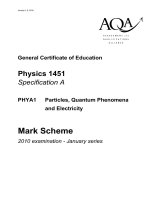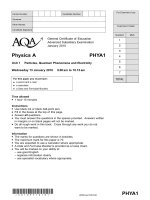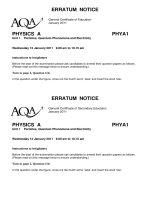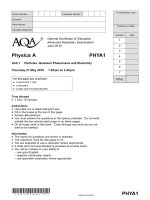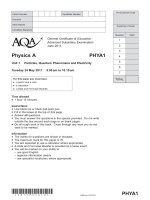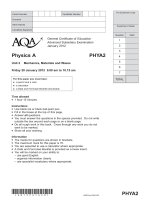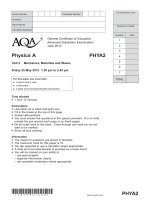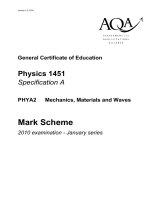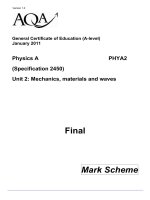- Trang chủ >>
- Khoa Học Tự Nhiên >>
- Vật lý
Vật lý A level:AQA PHYA2 QP JUN12
Bạn đang xem bản rút gọn của tài liệu. Xem và tải ngay bản đầy đủ của tài liệu tại đây (1.13 MB, 20 trang )
WMP/JUN12/PHYA2
PHYA2
Centre Number
Surname
Other Names
Candidate Signature
Candidate Number
General Certificate of Education
Advanced Subsidiary Examination
June 2012
Time allowed
●
1 hour 15 minutes
Instructions
●
Use black ink or black ball-point pen.
●
Fill in the boxes at the top of this page.
●
Answer all questions.
●
You must answer the questions in the spaces provided. Do not write
outside the box around each page or on blank pages.
●
Do all rough work in this book. Cross through any work you do not
want to be marked.
●
Show all your working.
Information
●
The marks for questions are shown in brackets.
●
The maximum mark for this paper is 70.
●
You are expected to use a calculator where appropriate.
●
A Data and Formulae Booklet is provided as a loose insert.
●
You will be marked on your ability to:
– use good English
– organise information clearly
– use specialist vocabulary where appropriate.
For this paper you must have:
●
a pencil and a ruler
●
a calculator
●
a Data and Formulae Booklet (enclosed).
Physics A PHYA2
Unit 2 Mechanics, Materials and Waves
Friday 25 May 2012 1.30 pm to 2.45 pm
MarkQuestion
For Examiner’s Use
Examiner’s Initials
TOTAL
1
2
3
4
5
6
7
(JUN12PHYA201)
WMP/JUN12/PHYA2
Do not write
outside the
box
Answer all questions in the spaces provided.
1 (a) (i) State two vector quantities.
vector quantity 1
vector quantity 2
1 (a) (ii) State two scalar quantities.
scalar quantity 1
scalar quantity 2
1 (b) The helicopter shown in Figure 1a is moving horizontally through still air. The lift
force from the helicopter’s blades is labelled A.
Figure 1a Figure 1b
1 (b) (i) Name the two forces B and C that also act on the helicopter.
B
C
(02)
2
74°
A
A
B
C
B
C
(2 marks)
(2 marks)
not to
scale
WMP/JUN12/PHYA2
Turn over
ᮣ
(03)
Do not write
outside the
box
1 (b) (ii) The force vectors are also shown arranged as a triangle in Figure 1b.
State and explain how Figure 1b shows that the helicopter is moving at a constant
velocity.
1 (c) The lift force, A, is 9.5 kN and acts at an angle of 74° to the horizontal.
Calculate the weight of the helicopter. Give your answer to an appropriate number of
significant figures.
answer = N
(3 marks)
Turn over for the next question
3
9
(2 marks)
WMP/JUN12/PHYA2
Do not write
outside the
box
4
(04)
2 In the 17
th
century, when thinking about forces, Galileo imagined a ball moving in the
absence of air resistance on a frictionless track as shown in Figure 2.
Figure 2
2 (a) Galileo thought that, under these circumstances, the ball would reach position C if
released from rest at position A. Position C is the same height above the ground as A.
Using ideas about energy, explain why Galileo was correct.
(3 marks)
A
ground
C
B
WMP/JUN12/PHYA2
Do not write
outside the
box
5
(05)
Turn over
ᮣ
2 (b) Galileo then imagined that the track was changed, as shown in Figure 3.
Figure 3
The slope beyond B was now horizontal.
On the axes below, sketch a speed – time graph for the ball from its release at A until it
reaches the position X shown in Figure 3. Indicate on your graph the time when the
ball is at B.
(3 marks)
2 (c) Newton later published his three laws of motion.
Explain how Newton’s first law of motion is illustrated by the motion of the ball
between B and X.
(2 marks)
A
X
B
moving ball
speed
time
time when
ball is at X
time when
ball is at A
0
8
WMP/JUN12/PHYA2
Do not write
outside the
box
(06)
6
3 A sprinter is shown before a race, stationary in the ‘set’ position, as shown in Figure 4.
Force F is the resultant force on the sprinter’s finger tips. The reaction force, Y, on her
forward foot is 180 N and her weight, W, is 520 N. X is the vertical reaction force on
her back foot.
Figure 4
3 (a) (i) Calculate the moment of the sprinter’s weight, W, about her finger tips.
Give an appropriate unit.
unit
(2 marks)
3 (a) (ii) By taking moments about her finger tips, calculate the force on her back foot,
marked X.
answer = N
(3 marks)
Y
X
W
F
0.26
m
0.63
m
0.41
m
answer =
WMP/JUN12/PHYA2
Do not write
outside the
box
7
(07)
Turn over
ᮣ
3 (a) (iii) Calculate the force F.
answer = N
(1 mark)
3 (b) The sprinter starts running and reaches a horizontal velocity of 9.3 m s
–1
in a distance of
35 m.
3 (b) (i) Calculate her average acceleration over this distance.
answer = m s
–2
(2 marks)
3 (b) (ii) Calculate the resultant force necessary to produce this acceleration.
answer = N
(2 marks)
10
WMP/JUN12/PHYA2
(08)
Do not write
outside the
box
8
4 Figure 5 shows a cross-section through an optical fibre used for communications.
Figure 5
4 (a) (i) Name the part of the fibre labelled X.
(1 mark)
4 (a) (ii) Calculate the critical angle for the boundary between the core and X.
answer = degrees
(2 marks)
normal
line
refractive index of X = 1.41
refractive index of the core = 1.46
core
i
r
X
Y
X
85°
30°
normal
line
WMP/JUN12/PHYA2
9
(09)
Turn over
ᮣ
4 (b) (i) The ray leaves the core at Y. At this point the fibre has been bent through an angle of
30
o
as shown in Figure 5.
Calculate the value of the angle i.
answer = degrees
(1 mark)
4 (b) (ii) Calculate the angle r.
answer = degrees
(2 marks)
Question 4 continues on the next page
Do not write
outside the
box
WMP/JUN12/PHYA2
Do not write
outside the
box
10
(10)
4 (c) The core of another fibre is made with a smaller diameter than the first, as shown in
Figure 6. The curvature is the same and the path of a ray of light is shown.
Figure 6
4 (c) State and explain one advantage associated with a smaller diameter core.
(2 marks)
8
normal
line
normal
line
core
85°
30°
WMP/JUN12/PHYA2
Do not write
outside the
box
11
(11)
Turn over
ᮣ
5 (a) Describe an experiment to accurately determine the spring constant k of a spring that is
thought to reach its limit of proportionality when the load is about 20 N.
Include details of the necessary measurements and calculations and describe how you
would reduce uncertainty in your measurements. A space is provided for a labelled
diagram should you wish to include one.
The quality of your written communication will be assessed in this question.
(6 marks)
WMP/JUN12/PHYA2
Do not write
outside the
box
12
(12)
5 (b) Two identical springs, each having a spring constant of 85 N m
–1
, are shown arranged in
parallel and series in Figure 7.
Figure 7
A load of 15 N is attached to each arrangement.
5 (b) (i) Calculate the extension for the parallel arrangement when the load is midway between
the lower ends of the springs.
answer = m
(2 marks)
5 (b) (ii) Calculate the extension for the series arrangement.
answer = m
(2 marks)
5 (b) (iii) Calculate the energy stored in the parallel arrangement.
answer = J
(2 marks)
15 N
parallel
15 N
series
WMP/JUN12/PHYA2
Do not write
outside the
box
13
(13)
Turn over
ᮣ
5 (b) (iv) Without further calculation, discuss whether the energy stored in the series arrangement
is less, or greater, or the same as in the parallel arrangement.
(3 marks)
Turn over for the next question
15
WMP/JUN12/PHYA2
Do not write
outside the
box
14
(14)
6 When a note is played on a violin, the sound it produces consists of the fundamental
and many overtones.
Figure 8 shows the shape of the string for a stationary wave that corresponds to one of
these overtones. The positions of maximum and zero displacement for one overtone are
shown. Points A and B are fixed. Points X, Y and Z are points on the string.
Figure 8
6 (a) (i) Describe the motion of point X.
(2 marks)
6 (a) (ii) State the phase relationship between
X and Y
X and Z
(2 marks)
6 (b) The frequency of this overtone is 780 Hz.
6 (b) (i) Show that the speed of a progressive wave on this string is about 125m s
–1
(2 marks)
320 mm
A
X
Y
Z
B
WMP/JUN12/PHYA2
15
(15)
6 (b) (ii) Calculate the time taken for the string at point Z to move from maximum displacement
back to zero displacement.
answer = s
(3 marks)
6 (c) The violinist presses on the string at C to shorten the part of the string that vibrates.
Figure 9 shows the string between C and B vibrating in its fundamental mode. The
length of the whole string is 320 mm and the distance between C and B is 240 mm.
Figure 9
6 (c) (i) State the name given to the point on the wave midway between C and B.
(1 mark)
6 (c) (ii) Calculate the wavelength of this stationary wave.
answer = m
(2 marks)
320 mm
C
AB
Do not write
outside the
box
16
(16)
WMP/JUN12/PHYA2
6 (c) (iii) Calculate the frequency of this fundamental mode. The speed of the progressive wave
remains at 125 m s
–1
.
answer = Hz
(1 mark)
13
Do not write
outside the
box
WMP/JUN12/PHYA2
Do not write
outside the
box
(17)
17
7 Figure 10 shows two ways in which a wave can travel along a slinky spring.
Figure 10
7 (a) State and explain which wave is longitudinal.
(2 marks)
7 (b) On Figure 10,
7 (b) (i) clearly indicate and label the wavelength of wave B
(1 mark)
7 (b) (ii) use arrows to show the direction in which the points P and Q are about to move as each
wave moves to the right.
(2 marks)
7 (c) Electromagnetic waves are similar in nature to wave A.
Explain why it is important to correctly align the aerial of a TV in order to receive the
strongest signal.
(2 marks)
END OF QUESTIONS
P
direction of wave travel
wave A
equilibrium
position
Q
wave B
7
WMP/JUN12/PHYA2
(18)
18
There are no questions printed on this page
DO NOT WRITE ON THIS PAGE
ANSWER IN THE SPACES PROVIDED
WMP/JUN12/PHYA2
(19)
19
There are no questions printed on this page
DO NOT WRITE ON THIS PAGE
ANSWER IN THE SPACES PROVIDED
WMP/JUN12/PHYA2
(20)
20
Copyright © 2012 AQA and its licensors. All rights reserved.
There are no questions printed on this page
DO NOT WRITE ON THIS PAGE
ANSWER IN THE SPACES PROVIDED

